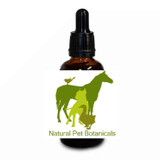Benign Fatty Growths (Lipomas) in Dogs
What are lipomas?
Lipomas are benign (non-cancerous) fatty tumors made of adipose tissue. They’re one of the most common lumps seen in dogs, especially middle-aged to senior dogs.
What do they feel like?
-
Soft, squishy, and movable under the skin
-
Usually painless
-
Slow-growing
-
Often found on the chest, abdomen, legs, or armpits
Which dogs are more prone?
Are lipomas dangerous?
Key takeaway:
Lipomas are usually benign and manageable, but any new lump should always be checked to confirm it’s truly harmless.
SET OF
BENIGN Fatty Growth Support
For educational purposes only. No therapeutic claims are made.
A carefully selected blend of natural, plant and mineral ingredients, traditionally valued for their supportive role in maintaining balance in skin and tissue health. This set is designed as part of a general wellness approach, encouraging comfort, resilience, and overall vitality when benign fatty growths are present.
Practitioner guidance may also recommend complementary lifestyle and dietary measures, including balanced nutrition and antioxidant support, to help maintain optimal wellbeing.
Supportive / holistic considerations
When to see the vet urgently
-
Lump becomes hard, painful, ulcerated, or rapidly enlarges
-
Sudden changes in shape or texture
-
Limping or reduced mobility
* Natural pet botanicals are not intended to replace veterinary care or medication. Our formulas are offered as an alternative health support for your animal's condition and not as a cure.
SET OF 4
1. Tissue Harmony 43-1 formula 30ml
2. Blood Vital 43-2 100ml
3. Topical 43-3 mix 50ml
4. Drawing Out 16 formula 50ml
Contains:
Formula 1.
Arbor Vitae (Thuja occidentalis) has long been symbolically associated with purification, renewal, and resilience. In traditional use, it has been linked with supporting balance in tissue wellness and maintaining harmony within the body.
Calcium Carbonate (Calcarea carbonica) is traditionally regarded as a symbol of stability and structure, reflecting its association with strength and resilience. It has often been connected with growth balance and the body’s natural cycles of renewal.
Brimstone (Sulphur) has historically been linked with warmth, transformation, and vitality. In traditional contexts it represents cleansing energies, renewal, and the maintenance of inner harmony.
Lithic Acid (Uricum acidum) is symbolically tied to purification and balance. Traditional associations suggest a connection with grounding and the steady release of what no longer serves the body.
Chorea (Castoreum) has been regarded in traditional practice as a substance connected with calming, harmonising, and restoring balance to natural rhythms. It reflects associations of steadiness and resilience.
Club Moss (Lycopodium clavatum) carries a long tradition of being seen as a plant of grounding and endurance. It has been symbolically linked with strength, clarity, and resilience of both body and mind.
Pure Flint (Silicea) is traditionally connected with clarity, purity, and endurance. Symbolically, it reflects structure and resilience, qualities long admired in natural healing traditions.
Ruta (Ruta graveolens), often known as Rue, is traditionally associated with strength, restoration, and balance. Its symbolic qualities include resilience, recovery, and grounding.
Calcarea Phosphorica (Calc Phos) is historically tied to growth, renewal, and structural integrity. Traditional associations connect it with balance in development and the natural processes of the body.
Carbon of Barium (Baryta carbonica) has long been linked with protection, resilience, and grounding. Traditional perspectives view it as a substance that supports harmony, strength, and the maintenance of balance in natural systems.
in 20% USP alc. in purified water.
Reference: https://www.researchgate.net/publication/256090732_Ruta_graveolens_from_Traditional_System_of_Medicine_to_Modern_Pharmacology_an_Overview
Bottle 2.
Medicinal Herbal Uses (Traditional and Historical Context)
Violet Leaves (Viola Odorata) have long been cherished in traditional herbal practice for their gentle yet strengthening qualities. Symbolically associated with calm, balance, and renewal, they have been linked with soothing and harmonising energies. Historically, Violet Leaves were valued for their connection to heart wellness, seasonal change, and supporting the body’s natural cycles of cleansing and restoration. Their delicate fragrance and soft energy have also made them a traditional emblem of peace, modesty, and resilience.
Reference: https://achs.edu/blog/2022/07/08/science-supports-violas-traditional-medicinal-value/
Dandelion Root (Taraxacum officinale) has been traditionally associated with cleansing, renewal, and vitality. Across many cultures it has been valued as a symbol of resilience and transformation, reflecting its ability to thrive in diverse environments. Historically, Dandelion Root was linked with supporting the body’s natural processes of digestion and elimination, while also being connected to strength, balance, and restoration. It has long been regarded as a plant that embodies adaptability, endurance, and the renewal of energy.
Reference: https://www.medicalnewstoday.com/articles/324083#10-possible-health-benefits
Burdock Root (Arctium lappa) has been traditionally associated with purification, grounding, and balance. In many traditions it has been regarded as a symbol of resilience and endurance, valued for its deep roots that reflect stability and strength. Historically, Burdock Root was connected with supporting the body’s natural cleansing and restorative processes, often linked to clarity, vitality, and renewal. It has also carried associations with protection, balance of inner energies, and the ability to restore harmony within.
Reference: https://pubmed.ncbi.nlm.nih.gov/20981575/
Milk Thistle (Silybum marianum) has long been associated with nourishment, renewal, and inner strength. Traditionally it has been connected with supporting the body’s natural processes of cleansing and restoration, particularly linked to vitality and resilience. Symbolically, Milk Thistle has been regarded as a plant of protection and endurance, reflecting both its hardy nature and its historical role in helping to bring balance, strength, and rejuvenation.
Reference: https://pubmed.ncbi.nlm.nih.gov/17548793/
Chamomile (Matricaria recutita) has traditionally been associated with calm, comfort, and gentle restoration. Across cultures it has been valued for its soothing qualities, often linked with easing restlessness and supporting relaxation. Symbolically, Chamomile represents peace, resilience, and renewal, reflecting its long-standing role as a gentle yet powerful ally for balance and harmony.
Reference: https://www.cochranelibrary.com/central/doi/10.1002/central/CN-01248214/full
Chickweed (Stellaria media) has traditionally been associated with cooling, soothing, and gentle cleansing qualities. In folk traditions, it was often linked with renewal, balance, and comfort, particularly in times of irritation or imbalance. Symbolically, Chickweed is connected with simplicity and resilience, reflecting its humble nature as a common yet valued plant that thrives in many environments while offering supportive and restorative qualities.
Reference: https://www.ncbi.nlm.nih.gov/pmc/articles/PMC7284062/
Cleavers (Galiuma parine) has traditionally been valued for its gentle cleansing and purifying associations. In herbal folklore, it was often linked with renewal, circulation, and the natural flow of energy, reflecting its long trailing growth habit. Symbolically, Cleavers is connected with clarity, release, and balance, representing the body’s ability to let go of what is no longer needed and restore harmony.
Reference: https://www.verywellhealth.com/colon-cancer-4014742
Self-Heal (Prunella vulgaris) has traditionally been regarded as a plant of restoration and resilience. In European and Asian traditions, it was often called “all-heal” or “heal-all,” symbolising its broad connection to wellbeing and recovery. Folklore associates it with renewal, balance, and inner strength, reflecting its purple blooms that were seen as a sign of vitality and harmony. Self-Heal carries a long-standing cultural link with supporting the body’s natural processes of repair and maintaining equilibrium.
Reference: https://www.ncbi.nlm.nih.gov/pmc/articles/PMC10460042/
Turmeric (Curcuma longa) has been valued for centuries across many cultures, particularly in Ayurveda and traditional Chinese practices, where it was seen as a golden spice symbolising vitality and balance. Its vibrant yellow colour was associated with purity, energy, and renewal, often used in rituals for protection and cleansing. Traditionally, turmeric was connected with supporting circulation, digestion, and the body’s natural processes of repair. It has also held a cultural place as both a culinary spice and a symbol of longevity, resilience, and overall wellbeing.
in purified water & 30%-40% USP alc.
Reference: http://cms.herbalgram.org/expandedE/Turmericroot.html
Bottle 3.
Chickweed has traditionally been associated with cooling, soothing, and gentle cleansing qualities. In folk traditions, it was often linked with renewal, balance, and comfort, particularly in times of irritation or imbalance. Symbolically, Chickweed is connected with simplicity and resilience, reflecting its humble nature as a common yet valued plant that thrives in many environments while offering supportive and restorative qualities.
Reference: https://www.ncbi.nlm.nih.gov/pmc/articles/PMC7284062/
Violet leaves (Viola Odorata) have long been cherished in traditional herbal practice for their gentle yet strengthening qualities. Symbolically associated with calm, balance, and renewal, they have been linked with soothing and harmonising energies. Historically, Violet Leaves were valued for their connection to heart wellness, seasonal change, and supporting the body’s natural cycles of cleansing and restoration. Their delicate fragrance and soft energy have also made them a traditional emblem of peace, modesty, and resilience.
Reference: https://achs.edu/blog/2022/07/08/science-supports-violas-traditional-medicinal-value/
Poke root (Phytolacca americana) has a long history of traditional use in North America and Europe, where it was regarded as a powerful herb associated with purification and renewal. In folk traditions, it was often linked with supporting the body’s natural processes of cleansing and balance, particularly relating to the lymphatic system. Culturally, poke root was sometimes used in rituals and remedies as a symbol of resilience, transformation, and vitality. Its presence in traditional practices reflects both its reputation as a strong plant and the deep respect it commanded for its potent, protective qualities.
Reference: https://www.healthline.com/health/poke-root
Reference: https://pubmed.ncbi.nlm.nih.gov/12639929/, https://pubmed.ncbi.nlm.nih.gov/15026348/
Oregano Essential Oil (anti-viral, anti-fungal, anti-bacteria) has been highly valued across many cultures for its strong, protective qualities. Traditionally, it has been associated with purity, resilience, and vitality, often used in folk practices to help safeguard the body against external challenges. In Mediterranean traditions, oregano was linked with strength and endurance, while its essential oil became known for its potent aromatic qualities that were believed to cleanse and restore balance. Revered for its warming and fortifying nature, oregano essential oil continues to be celebrated as a symbol of natural protection and resilience.
Reference: https://restorativemedicine.org/library/monographs/oregano/
Formula 4.
Calcium (Hepar sulph 4X) Traditionally associated with supporting the body’s natural processes of cleansing and elimination
Golden Seal (Hydrastis 1M) Traditionally regarded for supporting mucous membrane health and general vitality
Arbor Vitae (Thuja occidentalis 12X, 200C) Traditionally associated with tissue tone and balance
Bone-set (Symphytum 12X, 200C) Traditionally linked with structural and connective tissue support
Ash from Mount Hecla (Hekla Lava 12X, 200C) Traditionally regarded for oral and bone-related balance
Calcium Carbonate (Calcarea carbonica 30X) Traditionally associated with mineral balance and structural well being
Aqua fortis (Nitric acidum 200C) Traditionally linked with cleansing and revitalising qualities
Ucuuba (Myristica sebifera 14X) Traditionally regarded for tissue vitality and natural cleansing processes
Silica (Silicea 6X) Traditionally associated with supporting resilience and elimination
Mineral Oil (Kreosotum 14X, 12X, 200X) Traditionally linked with tissue balance and natural soothing effects
Wild Rosemary (Ledum 30C, 6X) Traditionally regarded for systemic balance and comfort
Oil of Mustard-seed (Thiosinaminum 13X, 12X) Traditionally associated with glandular balance and support
Poke-root (Phytolacca decandra 13X, 12X) Traditionally linked with supporting resilience and cleansing
Lymph Ease 33-3 formula
Clear flow 33-5 formula
20% USP alcohol in purified water.
Reference: https://pubmed.ncbi.nlm.nih.gov/32683037/
Reference: https://www.researchgate.net/publication/221855881_Comfrey_A_Clinical_Overview
Reference: https://www.healthline.com/health/poke-root
Need more advice or have more questions? Contact us for a FREE consultation with one of our fully qualified practitioners.
These statements are for general wellbeing and educational purposes only. This product is not intended to diagnose, treat, or prevent any disease. Always seek veterinary or professional advice for specific health concerns.
DISCLAIMER
The statements made regarding these products have not been evaluated by the Food and Drug Administration. The efficacy of these products has not been confirmed by FDA-approved research. These products are not intended to diagnose, treat, cure or prevent any disease. All information presented here is not meant as a substitute for or alternative to information from your health care practitioners. The Federal Food, Drug, and Cosmetic Act require this notice.

















